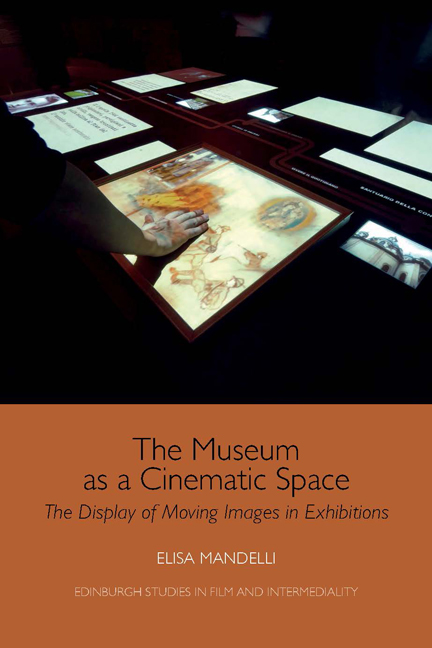Book contents
- Frontmatter
- Contents
- List of Figures
- Acknowledgements
- Preface
- Introduction
- Part I Between History and Modernity: Films in Exhibitions in the Twentieth Century
- Part II The Museum as a Cinematic Space: Museums and Moving Images in the Twenty-first Century
- 5 From the Museum Experience to the Museum as an Experience
- 6 Audio-visuals in Exhibitions
- 7 The Museum and its Spectres
- 8 A Walk through Images
- 9 New Interpretations of the Movie Theatre
- 10 Touching Images
- Conclusions
- Bibliography
- Index
6 - Audio-visuals in Exhibitions
from Part II - The Museum as a Cinematic Space: Museums and Moving Images in the Twenty-first Century
Published online by Cambridge University Press: 24 October 2019
- Frontmatter
- Contents
- List of Figures
- Acknowledgements
- Preface
- Introduction
- Part I Between History and Modernity: Films in Exhibitions in the Twentieth Century
- Part II The Museum as a Cinematic Space: Museums and Moving Images in the Twenty-first Century
- 5 From the Museum Experience to the Museum as an Experience
- 6 Audio-visuals in Exhibitions
- 7 The Museum and its Spectres
- 8 A Walk through Images
- 9 New Interpretations of the Movie Theatre
- 10 Touching Images
- Conclusions
- Bibliography
- Index
Summary
This chapter presents an overview of the various typologies of audio-visual texts used in museum exhibitions, preliminary to the analysis developed in the following chapters. I will focus on four main categories: archival footage (both ‘raw’ and manipulated), educational documentaries and specially designed montages, historical reconstructions (‘docufictions’), and video testimonies.
Archival Footage
In the first part of this book, we have seen how the footage of the Imperial War Museum had to be transferred from film to cards in order to be shown in the Mutoscopes. In a way, contemporary museums go through a similar process: archival photo and video footage, mostly preserved on fragile film reels, are being digitised in order to be included in exhibitions. This covert operation has a number of implications in terms of how images can be used, shown, manipulated, and received.
One of the first consequences of the greater flexibility of digital photo and video footage is the wider visibility of archives inside the museum space: visitors enjoy direct access to a large quantity of images that document historical events and that are seamlessly placed alongside objects or artworks. Moving images and photographs are showcased as if they were concrete exhibits, as witnesses to the past: they seem able to preserve, despite the change of format, their ‘ontological’ capacity to carry the trace of reality and offer direct access to past events. According to a belief rooted in the origins of the medium, the photographic image creates a univocal relation between the sign and its referent: images are perceived as objective representations of the real world, and hence as an ideal tool of historical preservation. Exhibitions, however, are never neutral: to the contrary, they constitutively imply a selection of the exhibits (be they objects or archival footage), based on their consistency with the museum's wider narrative.
In some cases, the exhibition is designed to problematise the items on display, revealing how images can convey a meaning that is different from what they apparently show. At the In Flanders Fields Museum in Ieper (Belgium), devoted to the First World War on the Flanders Western Front, the visit begins with the projection of archival footage on irregular, large curved panels. The archival footage shows the euphoric atmosphere and imagery of the Belle Époque.
- Type
- Chapter
- Information
- The Museum as a Cinematic SpaceThe Display of Moving Images in Exhibitions, pp. 82 - 90Publisher: Edinburgh University PressPrint publication year: 2019



